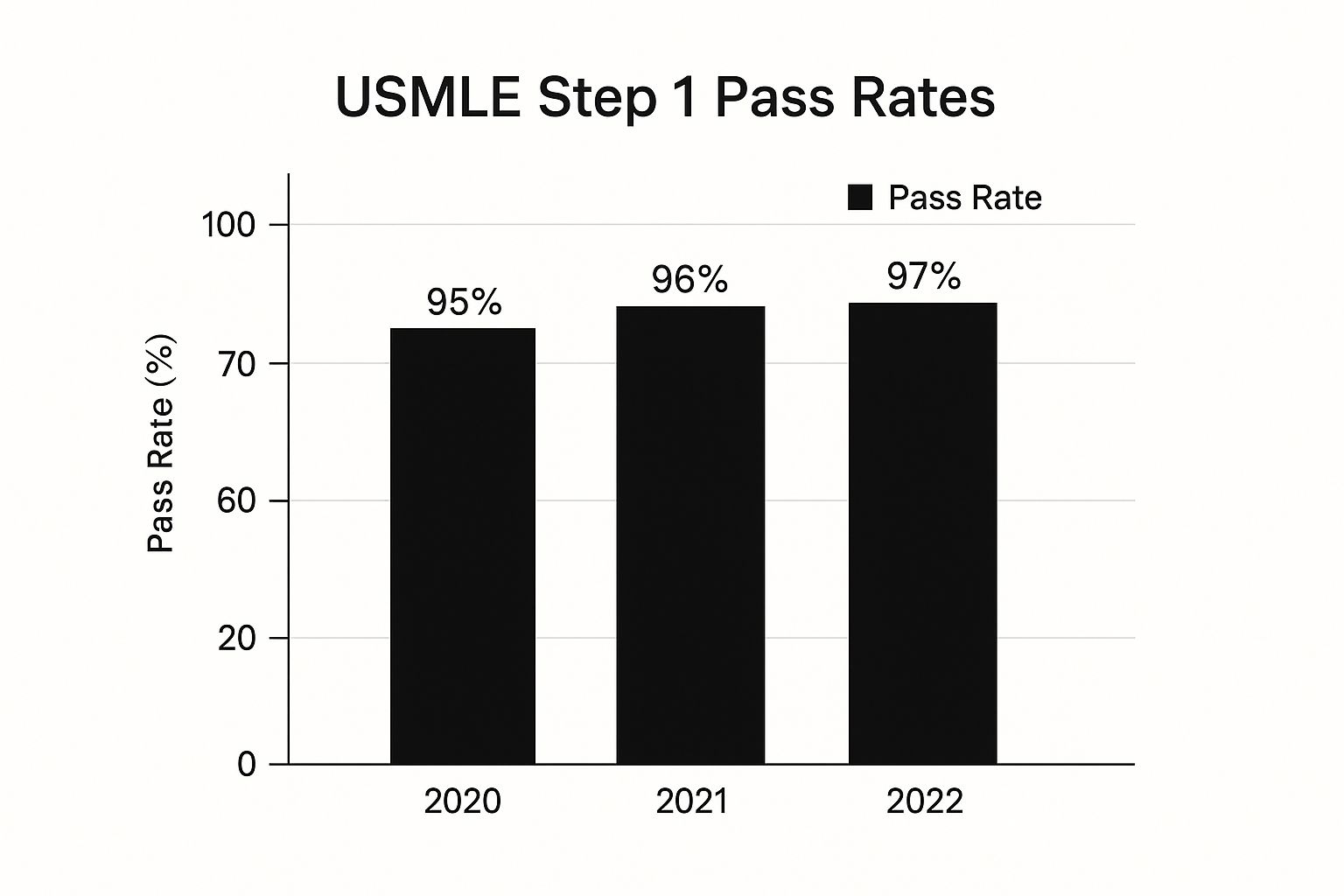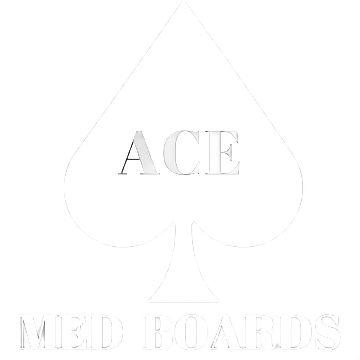Let's get straight to it. There's no longer a specific numeric USMLE Step 1 passing score that you or residency programs will ever see. Since January 26, 2022, the exam has been graded on a simple pass/fail basis. Your transcript will show one of those two outcomes, and that’s it.
Decoding the Step 1 Pass/Fail System

So, how do they decide if you pass? While your official report is binary, a numeric score is still calculated behind the scenes to determine the result. To get a "Pass," you have to meet the minimum performance standard set by the USMLE program. Historically, this standard lines up with a three-digit score of 196.
Think of it like getting your driver's license. The examiner doesn't give you a percentage score for your parallel parking or your three-point turn. They just assess your overall competency to decide if you're safe enough to be on the road. The result is a simple pass or fail. The USMLE Step 1 now works on a similar principle—it's about certifying you have the foundational knowledge for clinical practice, not ranking you.
The Rationale Behind the Change
This monumental shift wasn't made on a whim. It was a direct response to a growing crisis in medical education: the crushing pressure and student burnout tied to chasing an ever-higher three-digit score. The old system often pushed students to obsess over exam minutiae at the expense of developing true, long-term clinical understanding.
The move to a pass/fail outcome was designed to:
- Reduce student stress and improve well-being during one of the most demanding periods of medical school.
- Encourage a more holistic evaluation of residency candidates, pushing programs to look closer at clerkship performance, research, and other qualifications.
- Shift the focus back to learning the core concepts that actually matter for patient care, rather than just mastering test-taking hacks.
By ditching the numeric score, the USMLE program aimed to recenter the exam on its original purpose: ensuring a baseline standard of competency, not creating a numerical arms race. This change impacts every single aspect of how you should prepare for the exam and strategize for your residency application.
Understanding this new framework is the first step toward building an effective study plan. For a deeper dive into what this change means for you, check out our complete breakdown of USMLE Step 1.
Understanding the Shift from Numeric Scores to Pass Fail
To really get why the Step 1 scoring system looks the way it does today, we have to look back at what it used to be. For decades, a student's three-digit Step 1 score was the single most important number in their residency application. This created a culture of intense, almost obsessive competition.
The monumental shift to a simple pass/fail system on January 26, 2022, was a direct answer to this high-pressure environment. The organizations behind the exam, the FSMB and NBME, had one main goal: to improve student well-being. They wanted to dial back the burnout that came from endless "score chasing" and let students get back to genuine learning.
A Push for More Rounded Evaluations
The other big reason for the change was to nudge residency programs toward a more holistic way of evaluating candidates. When you take away that single, easy-to-compare number, programs are forced to look deeper. They have to consider the whole applicant—clerkship grades, research, letters of recommendation, and personal statements.
The shift aimed to change the narrative from "What was your score?" to "Who are you as a future physician?" It was a deliberate move to value broad competencies over a single test result.
This exam has always been a major hurdle. Its role as a gatekeeper grew massively over time. In the early 1990s, only 63.5% of U.S. medical schools required students to pass Step 1; by 2010, that number had jumped to 90%. You can dig into more data about the exam's role in medical education on PMC.
Historically, pass rates have always been a point of stress, with U.S. MD and DO students typically having higher success rates than International Medical Graduates (IMGs). The old numeric system just magnified this pressure, turning a basic competency check into an all-out competition. You can learn more about how the USMLE Step 1 pass/fail change impacts students in our detailed guide.
How a Pass/Fail Outcome Is Determined

With no three-digit score on your report, you might be wondering how the USMLE decides your fate. The truth is, a numeric score is still very much alive behind the scenes. Every exam gets graded internally, and your performance has to hit a specific minimum standard to earn that coveted "Pass."
That internal benchmark is the same as the old USMLE Step 1 passing score of 196. Essentially, nothing about the exam’s difficulty or the knowledge you need has changed—only the way the result is reported. You still have to clear the exact same bar as students did in the past.
Competency Over Comparison
Think of it like getting your CPR certification. During the final assessment, no one gives you a grade on the precise angle of your chest compressions or how fast you deliver breaths. Instead, the instructor just needs to see that you have the skills to act effectively in a real emergency. Once you prove you're competent, you're certified. Simple as that.
The USMLE Step 1 now works on a similar principle. It’s designed to certify your foundational medical knowledge—without ranking you against your peers—to ensure you’re ready for the next stage of clinical training.
Your official score report reflects this philosophy perfectly. It's a straightforward document that will only say “Pass” or “Fail.” This simplicity is intentional. By taking the numeric score out of the equation, the exam administrators want to shift the focus from chasing a high number to true, lasting learning. This whole approach encourages a deeper understanding of medicine, which is what really matters in the long run.
How the Pass Fail System Changed Residency Applications

When the numeric USMLE Step 1 passing score disappeared, it blew a massive hole in the residency application process. For decades, that one number was the go-to filter for program directors trying to sort through thousands of applicants. Now, with just a simple "Pass" on the report, the game has completely changed.
This shift means every other part of your application suddenly carries a lot more weight. Think of it like a table with four legs—if you kick one out, the other three have to be rock-solid to keep things from collapsing. Residency programs are now forced to look deeper, piecing together a different kind of puzzle to find their ideal candidates.
The New Pillars of Your Application
So, where is all that focus going now? It's shifted to a mix of other scores, hands-on performance, and the story your application tells about you.
The most obvious substitute for the old Step 1 score is now the USMLE Step 2 CK score. This three-digit number has quickly become the new primary academic filter for many programs. A strong performance on Step 2 CK is no longer just a bonus; it’s pretty much a necessity to get your foot in the door, providing the hard data that program directors are looking for.
But it’s not just about another exam. Other parts of your profile have been elevated from "nice-to-have" to "must-have."
- Clerkship Grades: Your performance during clinical rotations is now under a microscope. Consistently high marks show you can apply your knowledge in a real-world setting and have a strong work ethic when it counts.
- Research Experience: Meaningful research, especially if it leads to publications or presentations, is a huge differentiator. It tells programs you're intellectually curious and committed to advancing the field.
- Letters of Recommendation (LoRs): Glowing, personal letters from faculty who know you well are pure gold. They offer a crucial third-party perspective on your clinical skills, professionalism, and character.
In this new era, your residency application is less about a single high score and more about building a compelling narrative. You need to present a well-rounded profile that screams academic excellence, clinical potential, and genuine passion for medicine.
The moment the pass/fail change went live, program directors pivoted. Surveys from the National Library of Medicine showed that 89.1% of otolaryngology program directors, for example, now consider Step 2 scores their top metric.
Building a profile that stands out requires a deliberate, long-term strategy. It starts with a solid foundation, which is why you should check out our guide on how to prepare for USMLE Step 1 and succeed to ensure every piece of your application is as strong as it can be.
What Current Step 1 Pass Rates Reveal
So, did the switch to pass/fail make Step 1 easier? It’s a fair question, but the data tells a fascinating, and slightly unexpected, story. While the exam’s content and difficulty haven't changed, the move away from a numeric score hasn't necessarily made it any simpler to pass.
In fact, we’ve actually seen a noticeable dip in pass rates for some student groups since the change took effect on January 26, 2022. Before then, the USMLE Step 1 passing score was a firm 196. Around 95% of U.S. and Canadian MD students would clear that bar each year. For International Medical Graduates (IMGs), the pass rate was lower, sitting around 77% in 2021.
The surprising part? Even though the change was meant to lower the pressure, pass rates have slightly declined for both MD students and IMGs. You can get more insights into these pass/fail exam trends at Med School Coach.
Why the Dip?
This slight downturn hints at a couple of things. It’s possible some students are underestimating the exam's rigor, thinking "pass/fail" means "easy." Others might have dialed back their study intensity, no longer chasing that high three-digit score that defined earlier cohorts.
This chart shows the steady upward trend in pass rates for U.S. and Canadian first-takers in the years right before the big switch.

As you can see, these groups consistently performed at a very high level before the pass/fail system was introduced. The change seems to have disrupted that a bit.
USMLE Step 1 Pass Rate Comparison Pre vs Post Pass/Fail
To put the numbers in perspective, let's look at a side-by-side comparison of the approximate pass rates before and after the scoring change. This really highlights the subtle but important shifts.
| Student Group | Approximate Pass Rate (Pre-2022) | Approximate Pass Rate (Post-2022) |
|---|---|---|
| U.S./Canadian MD Students | ~95% | ~91-93% |
| U.S./Canadian DO Students | ~94% | ~90-92% |
| International Medical Graduates (IMGs) | ~77% | ~73-75% |
These numbers drive home the point that while the drops aren't massive, they are consistent across the board. The exam remains a formidable challenge.
The key takeaway is that Step 1 is still a major hurdle. A "Pass" is not a given; it's an outcome that demands the same rigorous preparation and deep grasp of medical science as it always has.
Got Questions About the Step 1 Exam? We've Got Answers.
The shift to a pass/fail Step 1 has stirred up a ton of questions. Let's cut through the noise and tackle some of the biggest concerns medical students have right now.
What Happens If I Fail Step 1?
Failing Step 1 isn’t the end of your medical journey, but you need a solid plan for what comes next.
The USMLE program gives you a few chances to get it right. You can retake the exam, but there's a limit—a maximum of four times. After a fourth failed attempt, you're no longer eligible to take Step 1.
It's also critical to know that every single attempt, pass or fail, shows up on your official USMLE transcript. Residency programs will see your entire exam history, which is why preparing to pass on the first try is so important.
Does "Pass" Mean The Exam Is Easier Now?
Not at all. This is probably the biggest misconception floating around.
The switch to pass/fail scoring didn't touch the exam's content, length, or difficulty. The questions are just as tough, and the standard for what constitutes foundational knowledge hasn't budged. The passing threshold is still set at the equivalent of the old 196 score.
A "Pass" simply certifies that you've met the established standard of competency. The exam itself is just as rigorous; it's only the reporting that's changed. Think of it as earning a license, not a letter grade.
How Should I Change My Study Strategy For A Pass/Fail Exam?
Your focus should pivot from chasing a high score to achieving deep, unshakable mastery of the material. Gone are the days of cramming obscure facts for a few extra points. Your new goal is to build a rock-solid foundation of core medical concepts.
Here’s where to direct your energy:
- Build Knowledge That Lasts: Aim for true retention that will serve you in clerkships and beyond, not just on exam day.
- Go for Conceptual Understanding: Move past rote memorization. You need to truly grasp the why behind physiological and pathological processes.
- Master High-Yield Topics: Concentrate your efforts on the material most likely to appear on the exam to ensure your foundation is strong enough to guarantee a pass.
Can Residency Programs See If I Failed Before Passing?
Yes, they absolutely can.
Your USMLE transcript is a complete, transparent record of your exam history. It lists every attempt for Step 1 and the result for each one—Pass or Fail. Programs will see the whole story.
This is exactly why walking into the exam with a bulletproof preparation plan is non-negotiable. A first-time pass is still the gold standard and sends a clear, confident signal that you're ready for the rigors of residency.
At Ace Med Boards, we help students build the deep conceptual knowledge needed to pass the USMLE Step 1 with confidence. Our expert tutors provide personalized guidance to ensure you are fully prepared for exam day. Start with a free consultation and see how we can help you succeed.
